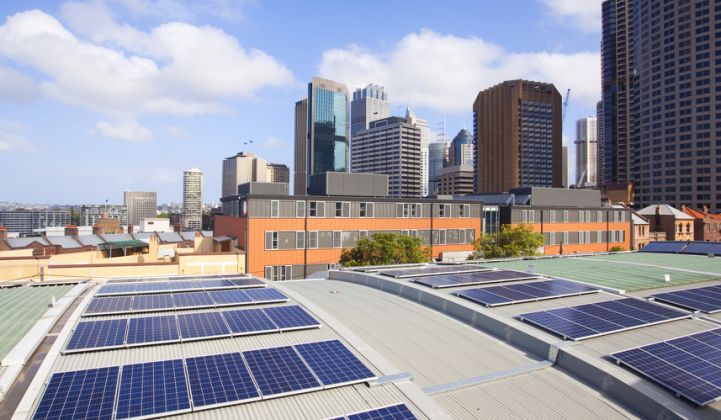While the residential and utility-scale solar markets post record growth, much of the commercial-scale solar market has seen relatively flat growth on a year-over-year basis.
GTM Research expects that 2014 will be the first time in 10 years that residential solar surpasses the non-residential sector. This is despite what we estimate to be a $2 billion to $4 billion market opportunity. With seemingly infinite rooftops and plots of land with unused space, why hasn’t the commercial solar industry boomed like other sectors?
The root cause is financing, which we'll explore below. But first, watch our video documenting the challenges in the "middle market" -- and the ways to address them.
Lack of standardization and a lot of fragmentation
There are a number of factors impacting the growth of the commercial solar market. However, the two greatest obstacles are a lack of standardization and high transaction costs relative to smaller deal sizes.
The only uniform aspect about the commercial solar market is its lack of uniformity. Standardized legal documents are not widely utilized; there is no set standard of technical specifications for project teams to follow; and there is no standardized process to underwrite credit.
Adding to this, hosts rarely sign on the dotted line without negotiating the power-purchase agreement (PPA), deal timelines may run long, and there are inevitably other project-specific issues that ratchet up transaction costs.
This lack of standardization contrasts sharply with the situation in the residential solar space, which has standardized PPA and lease contracts and uses easy-to-access FICO scores to assess creditworthiness. In residential markets, funds are closed in large tranches of homogenous deals, simplifying the process, minimizing transaction costs and creating potential liquidity, which lowers the cost of capital.
Although utility-scale solar projects are not standardized, the project size is large enough that even smaller 10-megawatt utility-scale deals can support higher transaction costs because they're proportionally small. This raises the second (and related) issue of the commercial solar market: negotiating these documents and running “shadow credit ratings” on all of these hosts is extremely time-intensive and therefore expensive. As a proportion of overall capex, transaction costs account for a disproportionate share of total costs in the domain of commercial-scale solar.
These obstacles have kept the commercial-scale sector fragmented, with no single company emerging as dominant. For now, YieldCos focus chiefly on the utility-scale markets, gobbling up projects (and more recently, companies) with portfolios of investment-grade offtake agreements. This is because YieldCos depend on portfolio growth to secure investors. SunEdison (and its YieldCo TerraForm) often buys projects in the commercial space from other developers, but incorporates this strategy with one of self-development, a challenging balancing act.
SolarCity has dabbled in working with partners, but generally it works directly with large-scale, big-box hosts, like Wal-Mart, which could potentially serve to limit scale. SolarCity’s latest shareholder presentations show that the solar giant constructed only 50 megawatts of commercial solar as of Q3 2014, compared to 276 megawatts of residential. Both larger players are fairly limited by the credit constraints facing outside tax equity investors.
Sol Systems’ strategy for the commercial and small utility markets is to scale through repeat transactions with developer partners, somewhat like third-party providers such as Sunrun and others have done for residential. Others, mainly local and regional players, leverage the “buy local” mentality to take advantage of local host relationships, many of which end up being cash deals.
Clearing the trail to scale commercial solar
This quote from Ralph Waldo Emerson sums up our approach: “Do not go where the path may lead; go instead where there is no path and leave a trail."
To scale the commercial sector and propel it past its $2 billion potential, market players must push a transformation in both efficiency and standardization. The following is critical:
- Working relentlessly to standardize processes
- Bundling projects into portfolios to command better pricing and efficiency
- Keeping overhead low; bringing legal and engineering expertise in-house
- Focusing on long-term partnerships that drive value for both parties. One-off commercial deals are inefficient and costly. Both partners can quickly scale to attack more deals -- and the right deals.
Finally, solar developers and investors must focus their commercial business on markets where deals are more likely to pencil out, such as the Northeast, the Mid-Atlantic and California.
In California, commercial solar projects can pencil out without incentives because of the high electricity prices. In the Northeast and Mid-Atlantic, incentive design, among other factors, is pushing developers away from the larger utility-scale projects and toward the rooftops. Examples of these states include stable SREC markets such as New Jersey, Maryland and Massachusetts (which also offers incentives for projects under 650 kW), as well as Connecticut’s ZREC Program and NYSERDA’s PON 2112.
Commercial solar is challenging, but not impossible. By mastering efficiency, scale, repeat transactions and favorable markets, this underserved sector of the market can produce at its potential and propel the solar industry forward.
***
Sara Rafalson and William Graves are senior associates at solar energy and investment firm Sol Systems. To date, the firm has financed 180 megawatts of solar energy assets throughout the United States.



